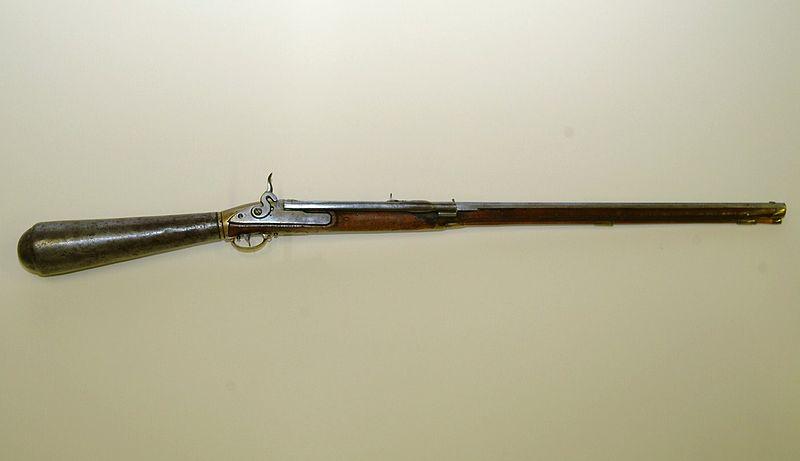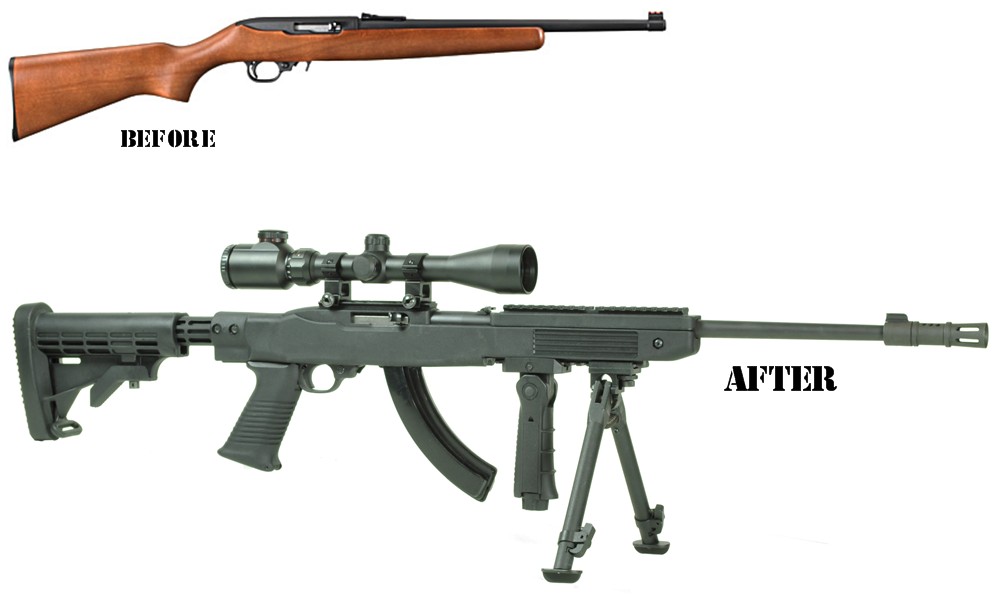I wasn’t ever intending to do this kind of thing for a few reasons. Mainly, it isn’t what this blog is about. However, the topic of gun control does bring up many decisions that people need to make for themselves, which IS a big part of what this blog is about. The biggest issue that faces a lot of people, whether they recognize it or not, is information vs. emotion. Though I’m going to break this into multiple parts, this is still going to be a fairly long post with plenty of links and citations.
This first part will focus on defining terms and include a little history. For this, I’m going to use various sources including Wikipedia. For the purpose of establishing history and definitions, it will be sufficient.
For a little personal background, I used to be in favor of gun control many years ago. I had done some target shooting with a .22 and air rifles and earned the Rifle Shooting merit badge at Boy Scout Camp. At the time of the Assault Weapons Ban in 1994, I was 14 and it made sense that restricting who gets what would result in fewer murders. It was perfectly logical in my adolescent brain that no one needed assault weapons.
Fast forward to today. I am a gun owner and a gun-rights advocate. I have a license to carry a handgun application currently in process with the Indiana State Police and am a member of the NRA (though not as much because of political clout as it’s a requirement for membership at several private shooting clubs). One of the goals on The List is to take a professional firearms training and have plans to attend two or three courses this year. I oppose re-instituting any increased regulation of firearms. So what changed?
Well, I’ll tell you what changed my position: the data.
Violence in the United States is not a simple issue. Beware anyone who tries to paint it as one. Before we can get into a discussion about how to solve problems, we need to understand what it is we’re actually talking about. As mentioned earlier, it seems best to start with some basic definitions and history of legislation.
An automatic firearm is what people refer to as a machine gun (or sub-machine gun). Rounds will continue to fire as long as the trigger is held. Every legally owned automatic firearm is registered under the National Firearms Act of 1934. The Firearms Owners Protection Act of 1986 (revising portions of the Gun Control Act of 1968) made it illegal for any civilian to own an automatic firearm produced after May 19, 1986. Any that were previously registered under the NFA were still legal.
A semi-automatic firearm is one that fires a single round with each press of the trigger, an important distinction to make. The spent casing is ejected automatically and a new round is then loaded into battery (ready to fire). The first successful semi-automatic rifle was the Mannlicher M85 (also called: Mannlicher 85 or Model 85), developed in 1883 and produced in 1885. Though this is my opinion, I believe that one of the causes of confusion between automatic and semi-automatic is that the latter is sometimes referred to as an “auto”. This isn’t a reference to the action (semi-automatic) but that it’s an “auto-loader” which means, as mentioned, it automatically ejects the spent casing and loads a new round into battery.
A magazine is a device, either removable or built in, for holding and feeding ammunition. These have a variety of shapes and capacities, the two most common being tube and box, but drums also exist. The first magazine appeared in the Girandoni Air Rifle in 1780, holding twenty-two .47 caliber balls. This rifle was actually used in military service for a great many years, including throughout the Napoleonic Wars. The first magazine fed firearm was the Spencer Repeating Rifle, using a tube magazine in the buttstock. The first detachable magazine firearm is usually considered to be the Borchardt C-93 pistol in 1893.

Girandoni Air Rifle (photo courtesy Wikipedia)
Spencer Repeating Rifle (photo courtesy Wikipedia)
Ammunition cartridges as we are used to seeing them today (a projectile in a metal casing containing a powder charge ignited when the firing pin strikes a primer) were first patented in 1847 with a rimfire cartridge called the .22BB. More modern centerfire cartridges were introduced shortly thereafter, though I’m unable to find a good source for a date on this. All I can verify that it was prior to 1870.
We’re not really discussing anything new, this is relatively old technology. In fact, there hasn’t really been any significant increase in small-arms technology in quite some time. Everything is either a refinement or repackaging of these previous technologies.
This brings us to one of the bigger and trickier portions of the whole discussion: the assault weapon.
As far as I can tell, the phrase itself didn’t even really exist, at least not in this context, prior to the 1993 introduction of the legislation resulting in the ban that lasted from 1994-2004. The term is often confused with assault rifle, which has a very specific definition. An assault rifle is a military service rifle with select-fire capability, meaning that it can be switched between automatic, burst, and semiautomatic (depending on the model) fire.
By contrast, the phrase assault weapon is a legal term that refers largely to the cosmetic characteristics of a firearm. This is a difficult thing to debate since everyone appears to have a different definition of what it is. During the previous ban enacted under the Public Safety and Recreational Firearms Use Protection Act, the definition was any semi-automatic firearm that possessed two or more specific characteristics. The full list can be seen at the above link. It should be reiterated that these were entirely cosmetic characteristics. Here’s an example of an extraordinarily common semi-automatic firearm, the Ruger 10/22.
These are both the same gun. The top is a stock 10/22, right out of the box. The bottom has a replacement stock and several other accessories. The receiver and action (where cartridges are loaded and fired) is the exact same. Both firearms pictured are semi-automatic rifles that fire a .22LR rimfire cartridge. One of them is considered an assault weapon, one is not.
Let’s look at the AR-15 platform, one of the most popular rifle platforms in the United States today. It was a semi-automatic civilian rifle modeled after the M16 military rifle. It should be noted that AR does not, in fact, stand for “assault rifle” but ArmaLite Rifle, named for ArmaLite, the company who created the specification. The most common chambering for the AR platform is the .223 Remington cartridge and its variant, 5.56 NATO.
.223 Remington is considered an intermediate cartridge. It is more powerful than many pistol cartridges but not as powerful as “battle rounds” such as the 7.62 NATO (.308 Winchester), and 30-06 Remington. The 5.56 NATO is standard rifle ammunition in Western military applications because it 1) is less powerful and so is easier to control recoil during burst or automatic fire and 2) is inexpensive and relatively lightweight. Here is a list of common cartridges and some information about each.
In civilian applications, the .223 Remington is most often considered a “varmint round”. Here is a common semi-automatic hunting rifle by Ruger, the Mini-14 Ranch Rifle, chambered in .223 Remington.
By this point, I’d be willing to bet almost everyone has seen an AR-15 so a photo isn’t necessary. If it is, there are plenty of them just a Google away. Functionally, the two are identical. They use identical intermediate cartridges and both only fire a single round with each press of the trigger.
This leads to the magazine capacity portion of the discussion, which is another area made difficult by nebulous language. Like “assault weapon”, the term didn’t really exist prior to 1993. It introduced the idea of a normal capacity magazine being a detachable device holding ten rounds or less. In point of fact, this number seems to be arbitrary and it was never made clear how it was chosen.
For decades, the standard capacity for many detachable rifle magazines has been either 20 or 30 rounds, going back to the introduction of the detachable magazine M16 in military service around 1959. Standard magazine capacities for pistols can range from 8-19 rounds, depending on the model and caliber. Once again, this has been the standard for many decades.
When the definitions are known, it seems as though use of the term “assault weapon” is disingenuous; it suggests any item utilized as a weapon with which to assault another person. Arbitrarily defining magazine capacity as either high or normal while ignoring what’s been standard is the same. This gentleman has produced a video that has made rounds on social media over the last week or so and has illustrated the use (and intentional misuse) of language better than I ever could.
It’s impossible for people to have a productive conversation unless they all speak the same language. Beyond that, if people are making decisions based on misconceptions and inaccurate data, those decisions are going to be fundamentally flawed. Information exchange is important for critical thought and good decision making but only if the information being exchanged is accurate. This is my intent here, to allow people to have the information necessary to make an adequately informed decision.
Now that the basic terminology and a little history have been laid out, my next post is going to be getting into crime in the United States.





Good setup… Dig the Youtube clip. Looking forward to the next post.